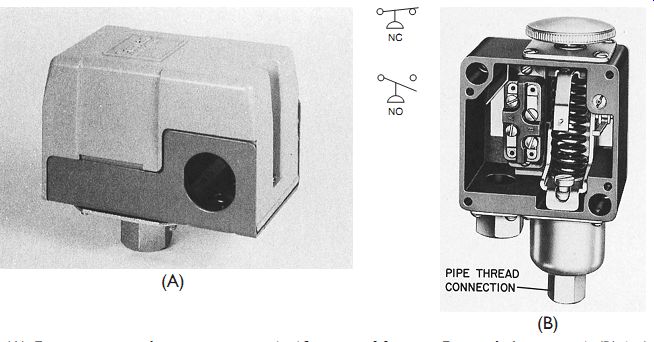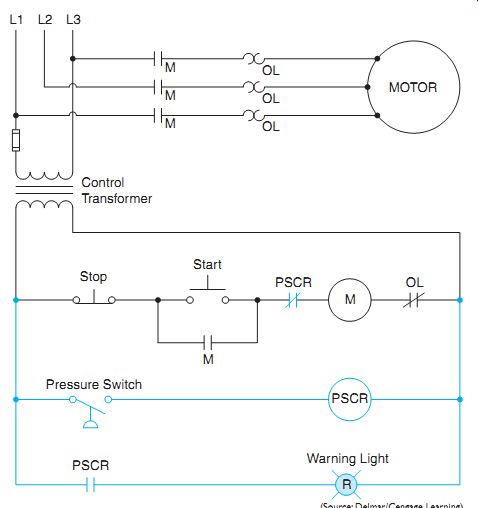AMAZON multi-meters discounts AMAZON oscilloscope discounts
Goals:
- • Describe how pressure switches, vacuum switches, and pressure regulators may control motors.
- • List the adjustments that can be made to pressure switches.
- • Identify wiring symbols used for pressure switches.
Any industrial application that has a pressure sensing requirement can use a pressure switch, Fgr. 1(A). Fgr. 1(B) shows the internal construction of a typical pressure switch. A large variety of pressure switches are available to cover the wide range of control requirements for pneumatic or hydraulic machines such as welding equipment, machine tools, high-pressure lubricating systems, and motor-driven pumps and air compressors.

Fgr. 1 (A) Exterior view of a pressure switch. (B) Industrial pressure switch
with the cover removed. Note the operating knob. Also note the wiring diagram
symbols for normally closed and normally open contacts.
The pressure ranges over which pressure switches can maintain control also vary widely.
E.g., a diaphragm-actuated switch can be used when a sensitive response is required to small pressure changes at low-pressure ranges, Fgr. 2.A metal bellows-actuated control is used for pressures up to 2000 pounds per square inch (psi). Piston-operated hydraulic switches are suitable for pressures up to 15,000 psi. In all of these pressure-controlled devices, a set of contacts is operated.
-------------------
The most commonly used pressure switches are single-pole switches. Two-pole switches are also used for some applications. Field adjustments of the range and the differential pressure (or the difference between the cut-in and cut out pressures) can be made for most pressure switches. The spring pressure determines the pressures at which the switch closes and opens its contacts.
Pressure regulators provide accurate control of pressure or vacuum conditions for systems.
When they are used as pilot control devices with magnetic starters, pressure regulators are able to control the operation of liquid pump or air compressor motors in a manner similar to that of pressure switches. Reverse-action regulators can be used on pressure system interlocks to prevent the start of an operation until the pres sure in the system has reached the desired level.
Pressure regulators consist of a Bourdon type pressure gauge and a control relay. Delicate contacts on the gauge energize the relay and cause it to open or close. The relay contacts are used to control a large motor starter in order to avoid damage or burning of the gauge contacts. Standard regulators will open a circuit at high pressure and close it at low pres sure. Special reverse-operation regulators will close the circuit at high pressure and open the circuit at low pressure.

Fgr. 2 Simplified pressure switch control.

Fgr. 3 High pressure turns off the motor and turns on a warning light.
Typical Application
Pressure switches are used in many common industrial applications. A circuit that's used to turn off a motor and turn on a pilot warning light is shown in Fgr. 3. In this circuit, a pressure switch is connected to a control relay.
If the pressure should become too great, the control relay will open a normally closed con tact connected to a motor starter to stop the motor. A normally open pressure switch control relay (PSCR) contact will close and turn on a pilot light to indicate a high-pressure condition.
Notice that in this example circuit, the pressure switch needs both normally open and normally closed contacts. This isn't a common contact arrangement for a pressure switch. To solve the problem, the pressure switch controls the action of a control relay. This is a very common practice in industrial control systems.
QUIZ:
1. Describe how pressure switches are connected to start and stop (a) small motors and (b) large motors.
2. What type of pressure switch is generally used to sense small changes in low-pressure systems?
3. A pressure switch is set to cut in at a pressure of 375 psi and cut out at 450 psi. What is the pressure differential for this switch?
4. A pressure switch is to be installed on a system with pressures that can range from 1500 psi to 1800 psi. What type of pressure switch should be used?
5. A pressure switch is to be installed in a circuit that requires it to have three normally open contacts and one normally closed contact. The switch actually has one normally open contact. What must be done to permit this pressure switch to operate in this circuit?
6. Refer to the circuit shown in Fgr. 3. If the pressure should become high enough for the pressure switch to close and stop the motor, is it possible to restart the motor before the pressure drops to a safe level?
7. Refer to the circuit shown in Fgr. 3. Assume that the motor is running and an overload occurs and causes the OL contact to open and disconnect coil M to stop the motor. What effect does the opening of the overload contact have on the pressure switch circuit?